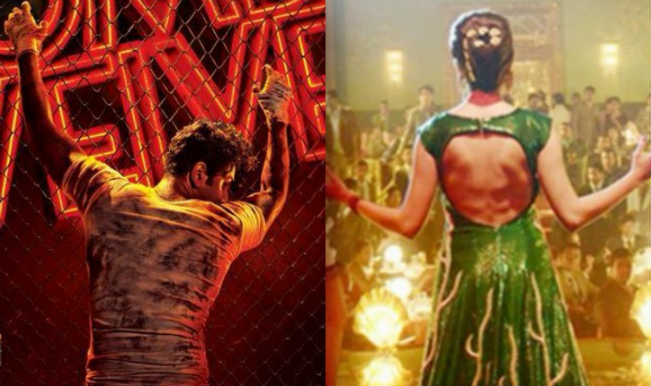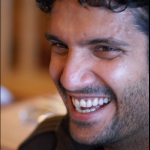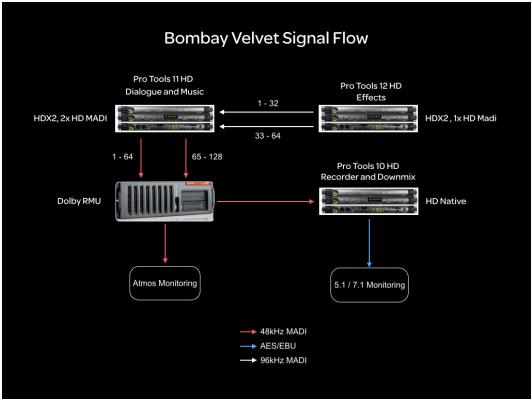The word ‘sound’ originates from the Latin word ‘sonus’, which means to convey a specified impression when heard. Sound is interpreted in many ways and is actually a medium far stronger than visuals if used optimally.
Dolby Atoms is one such technology that has enabled sound designers to experiment with the art that they specialise in and help them to create genuine effects for the sound that they sometimes need to recreate.
AnimationXpress.com recently caught up with the men behind the sound of the soon to release periodic drama ‘Bombay Velvet’ to understand the thought process and work flow of the sound design and mixing of a movie of this proportion and scale.
“I have associated with Anurag Kashyap on many of his earlier features and he is one director who really understands the nuances of sound, it’s always a pleasure working with him,” says Kunal Sharma, sound designer for Bombay Velvet.
The film which has long been in the making has been making headlines for various reasons over the past several months. Right from the casting of Karan Johar to play baddie Khambatta and his classy and suave look for the feature to Ranbir Kapoor training in martial art forms to reprise the role of Johnny Balraj, a street fighter who wants to make it big in life.

The storyline revolves around the protagonist Johnny Balraj as he falls for a beautiful jazz singer Rosie (Anushka Sharma), who is desired by every man who sets eyes on her. Theirs is the perfect love story… But not for long! Bombay of the 60s is brought to life beautifully onscreen with the lights, the glamour, the charm, men in dapper suits and women with bouffant hairdos – all of it is reminiscent of a retro Bombay, but the most important thing that brings all of this to life is the sound of the movie.
“This is for the very first that a movie is being completely recorded and mixed on 96 kHz using Dolby Atmos. The kind of freedom that we have using Atmos technology is something that we are very pleased with,” adds Sharma.
Sharma has earlier used 96 kHz recordings for movies like Udaan and Lootera, which were widely applauded for their respective sound designs and music. The work on Bombay Velvet for Sharma began nearly seven years ago during the making of Dev D and it was always about getting the right depth and feel for the sound to reflect the 1960s era of Bombay

On using 96 kHz specifically for the feature along with an Atmos mix, Sharma expounds: “We wanted to do it only on 96 kHz and Atmos as we wanted to give that kind of immersive experience to the audience.”
He further adds: “In layman terms if you understand visuals, then the difference between 2K and 4K resolutions is the difference between recording sound on 48 kHz and 96 kHz; that is the kind of texture and sound quality that you can experience.”
The most major hurdle that the team faced was to recreate the Bombay of the 60s, as they had to completely imagine the sound and music based on references and research material that they could get their hands on. “Working on Atmos gives us the liberty to overpower the visuals as there are a lot of things that you can play with, we can split the sound, make it travel across the theatre, but we are trying not to go overboard and keeping the sound as vintage as possible. We have kept the sounds very ‘fleshy’ during the fight sequences as well; so dont expect the ‘dishoom-dishoom’ sounds of that era,” he shares.
The movie has almost 80-85 per cent of sync sound and the remaining has been dubbed. According to the team, Atoms can help add a wow factor to the sound and they have used that to mix the songs so far, working alongside Amit Trivedi, with whom they have earlier worked on many projects.
Sharma informs: “There is a huge tendency of going loud in film mixes nowadays; people should get the feeling of the character, which is much possible with Atoms now. Once you are working on Atmos you can be sure that the sound will be the same even after the mix in the theatre. I have a brilliant team, in Justin and Sreejesh and we are just working on the first run of mixes that will be followed by the second and then the final run. We are attempting to have as much fun as we can and we hope we can succeed in our endeavour.”
 They are running the dialogue and music on a Pro Tools HDX2 System with 2 HD MADI IO and Version 11.3.1. The Effects, Foley and Ambience is running from another Pro Tools HDX2 system and 1 HD MADI IO with Version 12. And there is a third system which is an HD Native system with Pro Tools 10.3.9 that is used for recording the Mixdowns. All of these systems receive clock from a Rosendahl Clock generator.
They are running the dialogue and music on a Pro Tools HDX2 System with 2 HD MADI IO and Version 11.3.1. The Effects, Foley and Ambience is running from another Pro Tools HDX2 system and 1 HD MADI IO with Version 12. And there is a third system which is an HD Native system with Pro Tools 10.3.9 that is used for recording the Mixdowns. All of these systems receive clock from a Rosendahl Clock generator.
The advantage of running everything at 96 kHz also means there is more information in the higher frequency spectrum that has been recorded. Plus, the sounds that are being pitched for design sound are cleaner minus the artifacts.
If you look at the above diagram, you will see how the team managed to achieve the flow in Dolby Atmos to maintain the sample rate through the session. Once they attained this, they budgeted their objects and split the dialogue, music and effects system.
Coming to the mixing stage, Sreejesh Nair and Justine Jose are the craftsmen working their magic on the mix of the sound for Bombay Velvet. “The look of the film is very retro, so we want to give it a realistic feeling while paying homage to the retro style of the 60s, thus we have given importance to the origin of the sound, like the texture of the sound for the traffic and cars of that era,” reveals Nair.
Everything has been recorded on a high sample rate, as it gives them that much more depth to play with the sound. “It’s like if you see a movie on the blu-ray disc and then go back to watching a DVD of the same, it just doesn’t feel the same; similarly once you experience Atmos you can’t really work with anything else,” Nair asserts.
Both the mixers feel Atmos helps in taking the audience into the story, with a possibility of getting a lot more layers going into the sound design and the resolution that this particular sound format offers is unparallel and that can attempt to do a lot more changes to bring more reality to the sound.

“Atmos gives us the option of creating the right geography of the environment that we are shooting in; earlier if we watched a movie, the balcony seat cost the most but honestly that would sound the worst, thus people preferably wanted to sit in the middle of the theatre, but with Atmos seating is irrelevant as the sound has the flexibility to travel across the theatre,” he exults.
The team has used camera sound, booms, lapels, ambience sound, which have all been recorded at the same time, and they have then decoded that into 5.1; and even the location sound that one can hear in a room would be exactly how he/she will hear the sound if on location.
Nair further explains: “Working with 96 kHz also reduces the number of tracks that are created, so if there are 512 tracks per system that would then be halved to 256 tracks and we have two systems of pro tools that are literally maxed out now with the mixes. We are also using a lot of analogue gear to bring the sense of originality to the sound.”
Usually films are recorded on 48 kHz and all of the sound libraries are also accustomed to the 48 kHz mix, but when Kunal decided to do the movie on 96 kHz, the team has taken the onus to do everything on 96 kHz leading to being the first film in the world to be mixed on Atmos at 96 kHz.
There is a lot of research that has gone into actually understanding the kind of sound and music which should be used in the film as none of the crew members have actually witnessed the 60s era and it was of utmost importance to bring that flavor; and if the trailer is anything to go by, then the whole cinematic experience is certainly going to be one heck of a ride!
